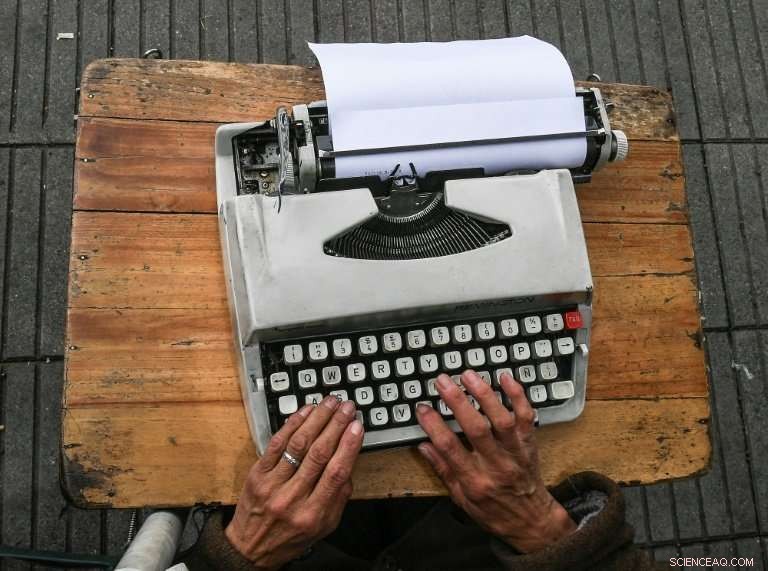
Les greffiers colombiens travaillent en plein air avec leurs machines à écrire perchées sur une petite table devant eux
Avant le 1er mai, reporters de l'AFP, les équipes vidéo et photo se sont entretenues avec des hommes et des femmes du monde entier dont les métiers se font de plus en plus rares, d'autant plus que la technologie transforme les sociétés.
Les derniers greffiers de la rue de Bogota
En insérant une feuille vierge dans son Remington Sperry, Candelaria Pinilla de Gomez commence à taper. L'un des greffiers de la rue de Bogota, elle a passé les 40 dernières années à taper d'innombrables milliers de documents.
63 ans, elle est la seule femme parmi les greffiers à avoir installé leurs minuscules tables sur le trottoir à l'extérieur d'un immeuble de bureaux moderne à Bogota.
Porter des costumes mais pas de cravates, les écrivains travaillent en plein air, sous un parasol, assis sur une chaise en plastique avec la machine à écrire sur leurs genoux.
Il était une fois, ces clercs ont joué un rôle essentiel - avec les actes publics, les documents fiscaux et les contrats passant entre leurs mains.
Pinilla de Gomez a appris le métier de son mari lorsqu'ils sont arrivés dans la capitale colombienne dans les années 1960. Il avait une ferme " mais les guérilleros l'ont enlevée, " elle dit.
« À Bogota, il m'a dit que je devrais apprendre à taper... et à épeler. Il m'a appris (le travail) et puis il est mort."
César Diaz, maintenant 68, se targue d'être le pionnier d'un métier qui a fini par devenir un "refuge" pour les retraités désireux de compléter leurs allocations mensuelles.
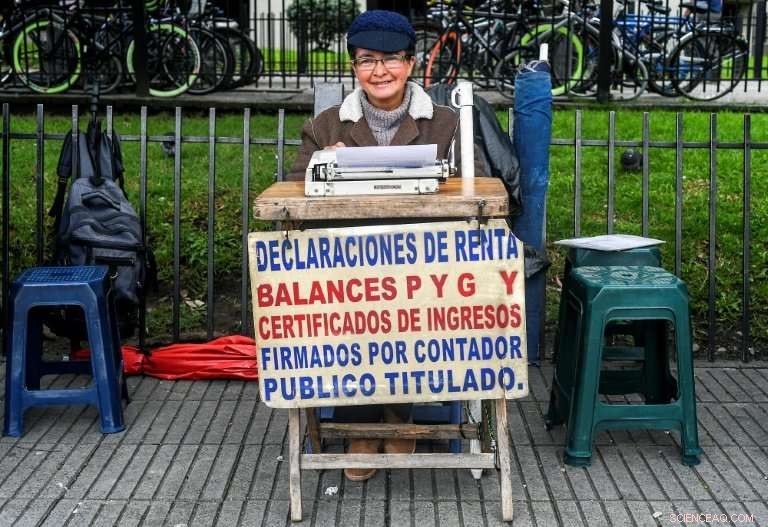
Candelaria Pinilla de Gomez, 63, travaille comme commis de rue à Bogota depuis une quarantaine d'années
Ils travaillent du lundi au vendredi et gagnent moins de 280 $, soit le salaire minimum.
Jusqu'à maintenant, ils ont réussi à survivre à peu près à tout, sauf peut-être à l'avènement d'Internet.
"Ces jours, une mère demandera à son fils de télécharger un formulaire, le remplir et l'envoyer par internet, " admet Pinilla de Gomez.
"Cela fout vraiment le bordel pour nous."
— Images de Luis Acosta. Vidéo de Juan Restrepo
Lavandières, leur commerce disparaissant comme du savon dans l'eau
Les mains de Delia Veloz ont presque perdu leurs empreintes digitales à cause du mouvement rythmique constant du frottement des vêtements sales contre des pierres brutes dans une ancienne laverie publique de Quito.
Avec une tignasse de boucles grises bouclées, cette femme de 74 ans est l'une des rares personnes en Equateur à exercer encore le métier ancien et exigeant de lavandière, métier de plus en plus rare en raison de l'utilisation généralisée des machines à laver domestiques.
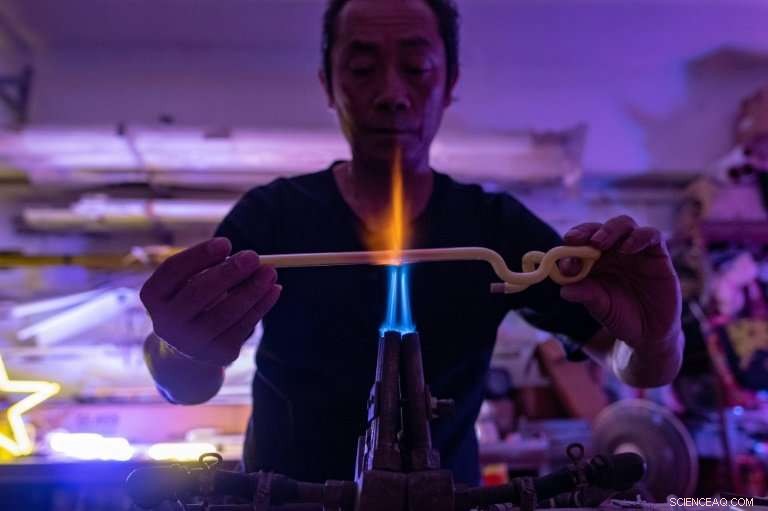
Wu Chi-kai plie des tubes de verre saupoudrés de poudre fluorescente à l'intérieur sur un puissant brûleur à gaz
"Je n'aime pas les machines à laver, ils ne se lavent pas très bien. Vous pouvez mieux frotter les choses à la main, ", raconte avec fierté Veloz à l'AFP en versant un pot d'eau glacée des Andes sur une veste.
Depuis plus de cinq décennies, elle travaille à l'Ermita, une laverie publique dans le centre colonial de Quito avec sa pierre rectangulaire, réservoir d'eau et divers fils pour suspendre les choses à sécher.
Pour 12 vêtements, elle gagne 1,50 $ (1,20 euro) auprès de ses clients de plus en plus rares, principalement ceux qui n'ont pas de machine à laver ou qui préfèrent que les choses soient lavées à la main.
Dans un bon jour, elle peut gagner entre 3 $ et 6 $.
A Quito, il y a encore au moins cinq lavoirs publics qui ont été construits dans la première moitié du 20ème siècle.
Il y a aussi ceux qui viennent utiliser la blanchisserie pour laver leurs propres vêtements ou ceux appartenant à leurs employeurs – pour lesquels il n'y a pas de frais.
Et une fois par mois, ils se réunissent tous pour garder les lieux propres et rangés.
— Images de Rodrigo Buendia
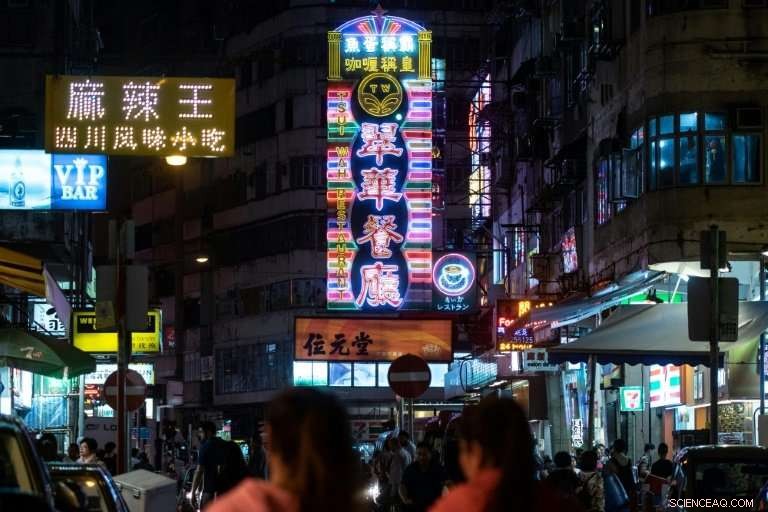
Le néon est venu définir le paysage urbain à Hong Kong, avec d'énormes panneaux clignotants dépassant horizontalement des côtés des bâtiments
Les waterboys commencent à tarir
Le manque d'eau courante dans les quartiers les plus pauvres du Kenya a, depuis 18 ans, signifiait une vie pour Samson Muli, un vendeur d'eau dans le bidonville de Kibera à Nairobi.
"En grandissant, je voulais être un homme d'affaires, " dit le père de deux enfants de 42 ans, qui fournit de l'eau aux bouchers, poissonniers et restaurants sur le marché bondé de Kenyatta.
Vêtu d'un pare-poussière, Muli utilise un tuyau pour remplir sa gamme de jerrycans cylindriques de 20 litres avec de l'eau provenant de trois 10, Réservoirs de 000 litres. Il en charge 15 à la fois sur un chariot, et les rapporte à ses clients.
Les marges sont minuscules - Muli achète de l'eau à cinq shillings (0,05 $) la canette et la vend 15 - mais cela peut aller jusqu'à 1, 000 shillings par jour, assez pour faire la différence.
"This job has changed my life because my children are able to go to school and I am able to afford to pay school fees for them, " il dit.
But Kenya's gradual development and the spreading provision of basic infrastructure, including piped water, means Muli's profitable days are numbered.
— Pictures by Simon Maina. Video by Raphael Ambasu
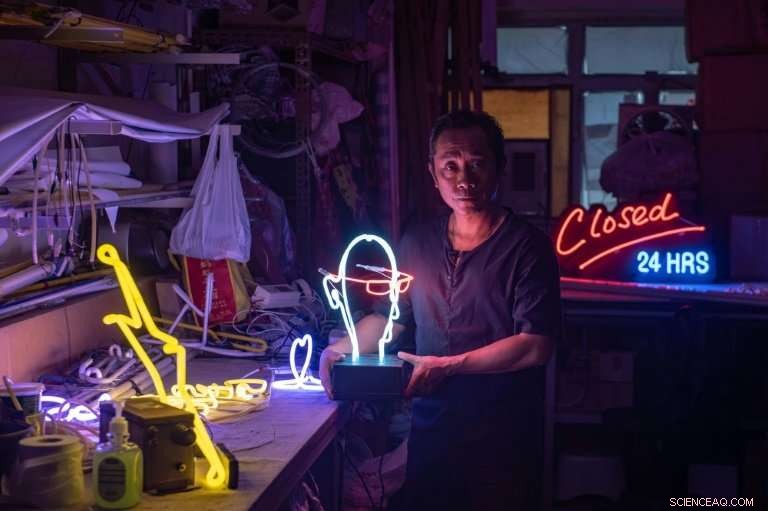
Chi-kai works without a safety visor and has been scalded and cut by glass which sometimes cracks and explodes
Rickshaw pullers fade from India's streets
Mohammad Maqbool Ansari puffs and sweats as he pulls his rickshaw through Kolkata's teeming streets, a veteran of a gruelling trade long outlawed in most parts of the world and slowly fading from India too.
Kolkata is one of the last places on earth where pulled rickshaws still feature in daily life, but Ansari is among a dying breed still eking a living from this back-breaking labour.
The 62-year-old has been pulling rickshaws for nearly four decades, hauling cargo and passengers by hand in drenching monsoon rains and stifling heat that envelops India's heaving eastern metropolis.
Their numbers are declining as pulled rickshaws are relegated to history, usurped by tuk tuks, Kolkata's famous yellow taxis and modern conveniences like Uber.
Ansari cannot imagine life for Kolkata's thousands of rickshaw-wallahs if the job ceased to exist.
"If we don't do it, how will we survive? We can't read or write. We can't do any other work. Once you start, c'est ça. This is our life, ", raconte-t-il à l'AFP.
Sweating profusely on a searing-hot day, his singlet soaked and face dripping, Ansari skilfully weaved his rickshaw through crowded markets and bumper to bumper traffic.
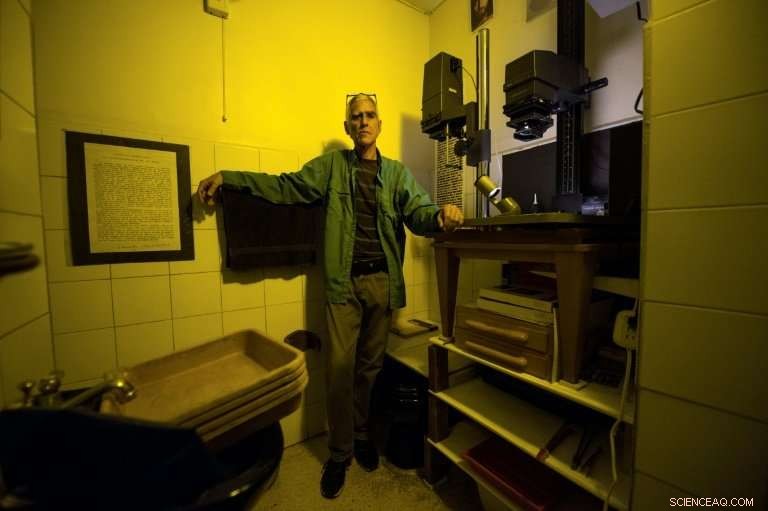
Venezuelan darkroom technician Rodrigo Benavides refuses to go digital
Wearing simple shoes and a chequered sarong, the only real giveaway of his age is a long beard, snow white and frizzy, and a face weathered from a lifetime plying this trade.
Twenty minutes later, he stops, wiping his face on a rag. The passenger offers him a glass of water—a rare blessing—and hands a bill over.
"When it's hot, for a trip that costs 50 rupees ($0.75) I'll ask for an extra 10 rupees. Some will give, some don't, " il dit.
"But I'm happy with being a rickshaw puller. I'm able to feed myself and my family."
— Pictures by Dibyangshu Sarkar. Video by Atish Patel
Hong Kong's neon nostalgia
Neon sign maker Wu Chi-kai is one of the last remaining craftsmen of his kind in Hong Kong, a city where darkness never really falls thanks to the 24-hour glow of myriad lights.
During his 30 years in the business, neon came to define the urban landscape, huge flashing signs protruding horizontally from the sides of buildings, advertising everything from restaurants to mahjong parlours.
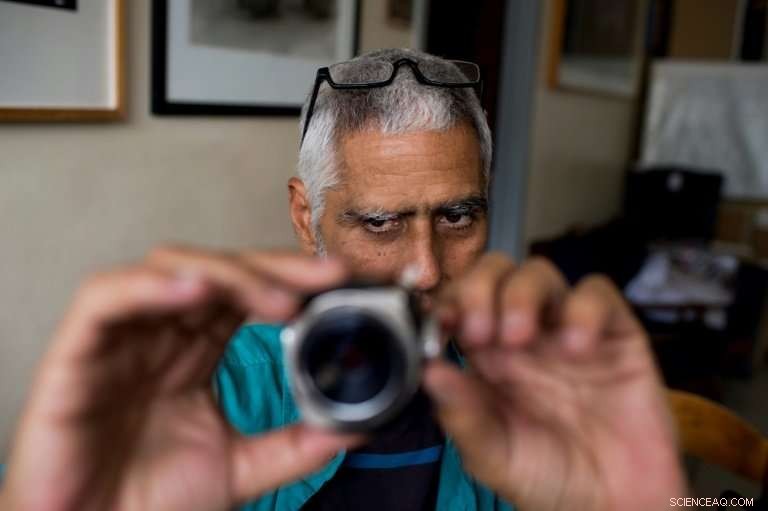
Although working with equipment and techniques that have virtually disappeared, he carries on as if digital photography does not exist
But with the growing popularity of brighter LED lights, seen as easier to maintain and more environmentally friendly, and government orders to remove some vintage signs deemed dangerous, the demand for specialists like Chi-kai has dimmed.
Despite a waning client-base, the 50-year-old continues in the trade, working with glass tubes dusted inside with fluorescent powder and containing various gases including neon or argon, as well as mercury, to create different colours.
He bends them into shape over a powerful gas burner at a scorching 1, 000 degrés Celsius.
"Being able to twist straight glass materials into the shape I want, and later to make it glow—it's quite fun, ", raconte-t-il à l'AFP, though it is not without risks.
Chi-kai works without a safety visor and has been scalded and cut by glass which sometimes cracks and explodes.
"The painful experiences are the memorable ones, " he adds philosophically.
His father used to scale Hong Kong's famous bamboo scaffolding while installing neon signs across the city.
Believing the installation work too dangerous for his son, he instead encouraged him to learn to make the signs as a teenager. Chi-kai became one of only around 30 masters of the craft in Hong Kong, even in neon's heyday.
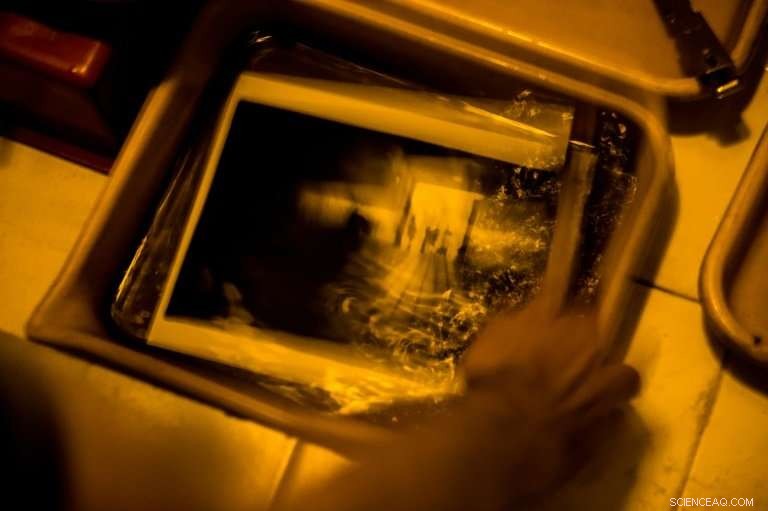
Using his bathroom as a makeshift lab, he develops negatives, turning them into black and white prints
Although demand is now significantly lower than at neon's peak in the 1980s, il dit, there has been renewed interest and nostalgia for its gentler glow, immortalised in the atmospheric movies of award-winning Hong Kong director Wong Kar-wai.
Some of Chi-kai's clients are now requesting pieces for indoor decoration.
"I've been working with neon lights all my life. I can't think of anything else I'd be better suited for, " il dit.
— Pictures by Philip Fong. Video by Diana Chan
Developing film as if digital didn't exist
With an ancient 50-year-old Olympus camera and an enlarger that he bought in 1980, Venezuelan photographer Rodrigo Benavides works his "magic" inside a tiny improvised darkroom at home.
Although working with equipment and techniques that have virtually disappeared, he carries on as if digital photography doesn't exist.
"Doesn't interest me at all, " il dit.
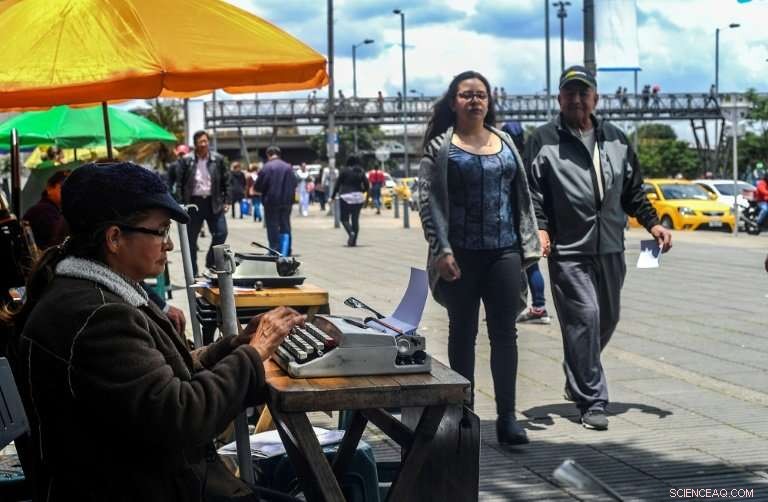
Once upon a time, these clerks played an essential role—with public deeds, tax documents and contracts all passing through their hands
Using his bathroom as a makeshift lab, he develops negatives, turning them into black and white prints. And it still fascinates him every time as the image slowly emerges on coming in to contact with the chemicals.
"I have always tried to be economical with my resources, always have done, always will do, " il dit, extolling the wonders of his Olympus 35 SP which uses a reel of film, doesn't need batteries and is completely manual.
Born in Caracas 58 years ago, he still remembers the excitement when, at the age of 19, he bought the enlarger in London.
And it was there that he became a keen follower of Group f/64, an influential movement of photographers who championed sharp-focused, unretouched images of natural subjects.
He thinks technology has "upended" photography, turning it into a work of "fiction."
"We have become desensitised to reality, which is much more interesting than fiction, " il dit.
Some 400 of his pictures taken over 30 years have been compiled into a book on the Venezuelan plains. Others are stacked up in his living room, forming a towering pile, some two meters high.
"They are like my children, " says Benavides, who describes himself as a documentary photographer practising a trade on the verge of extinction.
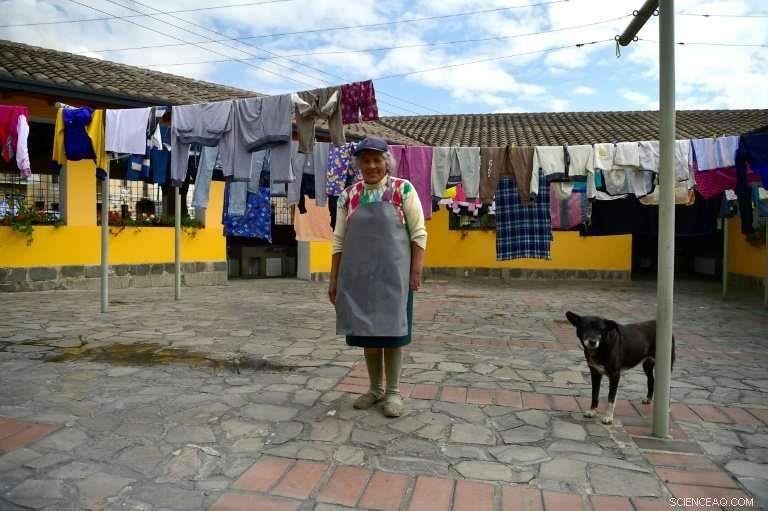
Delia Veloz, 74, is one of the few people left in Ecuador who still practises the ancient and demanding work of a washerwoman
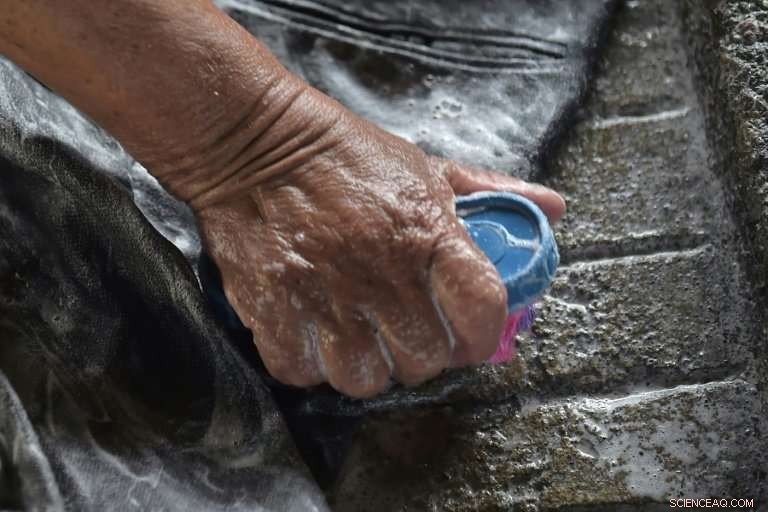
Washerwomen rub dirty clothes against rough stones at an old public laundry in Quito
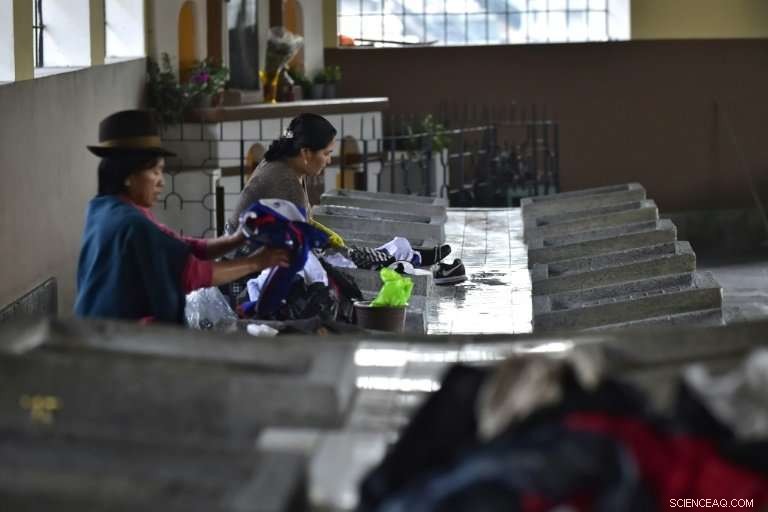
In Quito, there are still at least five public laundries which were built in the first half of the 20th century
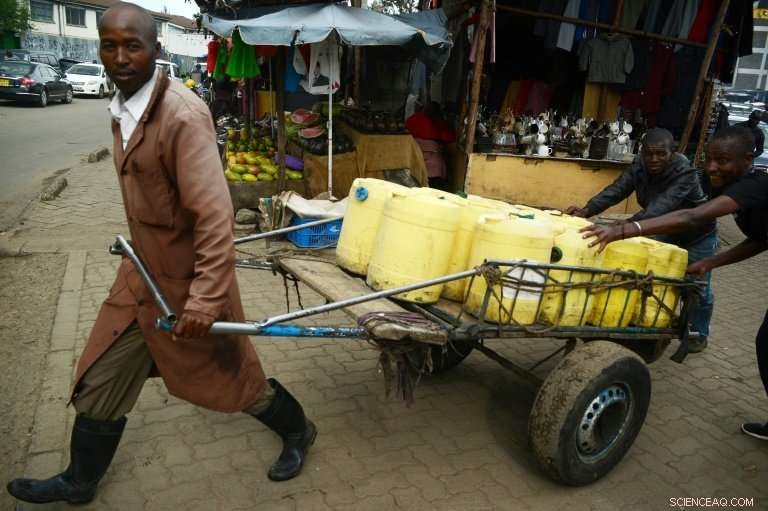
The lack of running water in Kenya's poorest neighbourhoods has meant a living for Samson Muli, a water seller in Nairobi's Kibera slum
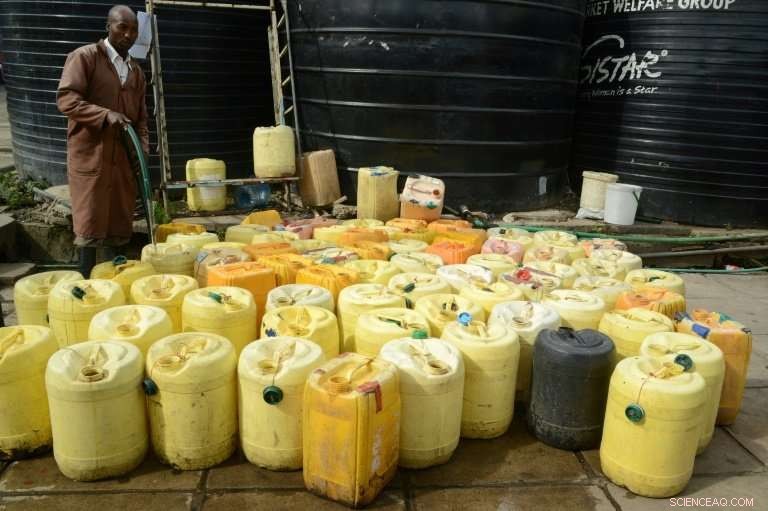
Waterboys supply water to butchers, fishmongers and restaurants in the crowded Kenyatta market
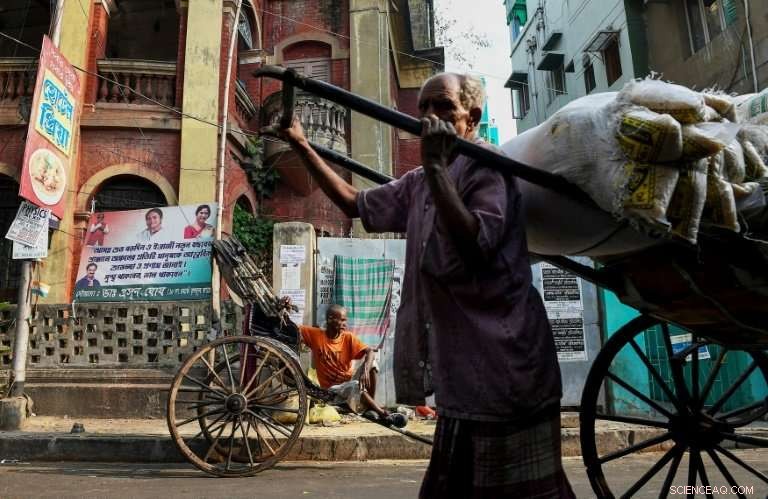
Kolkata is one of the last places on earth where pulled rickshaws still feature in daily life
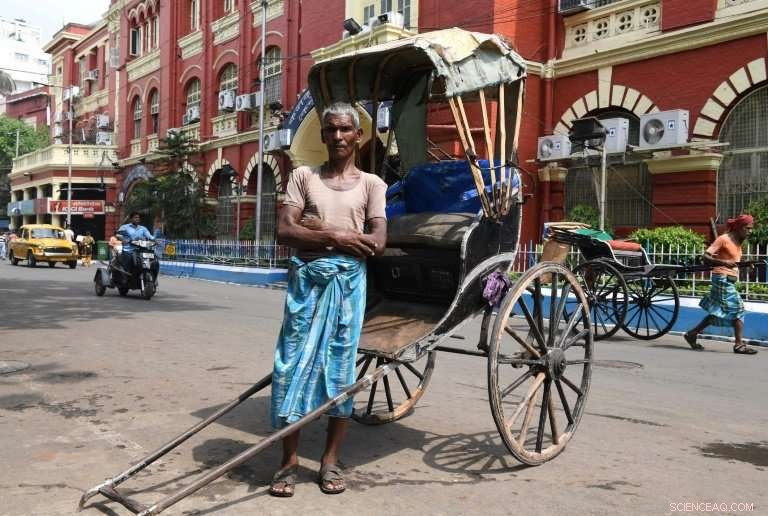
Mohammad Ashgar is one of the remaining Indian rickshaw pullers undertaking the gruelling trade
© 2018 AFP